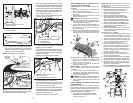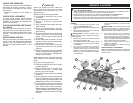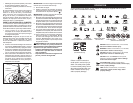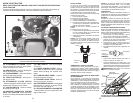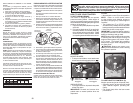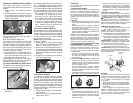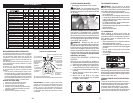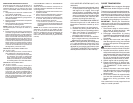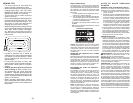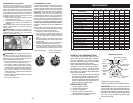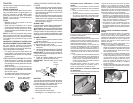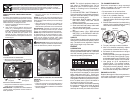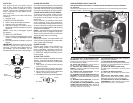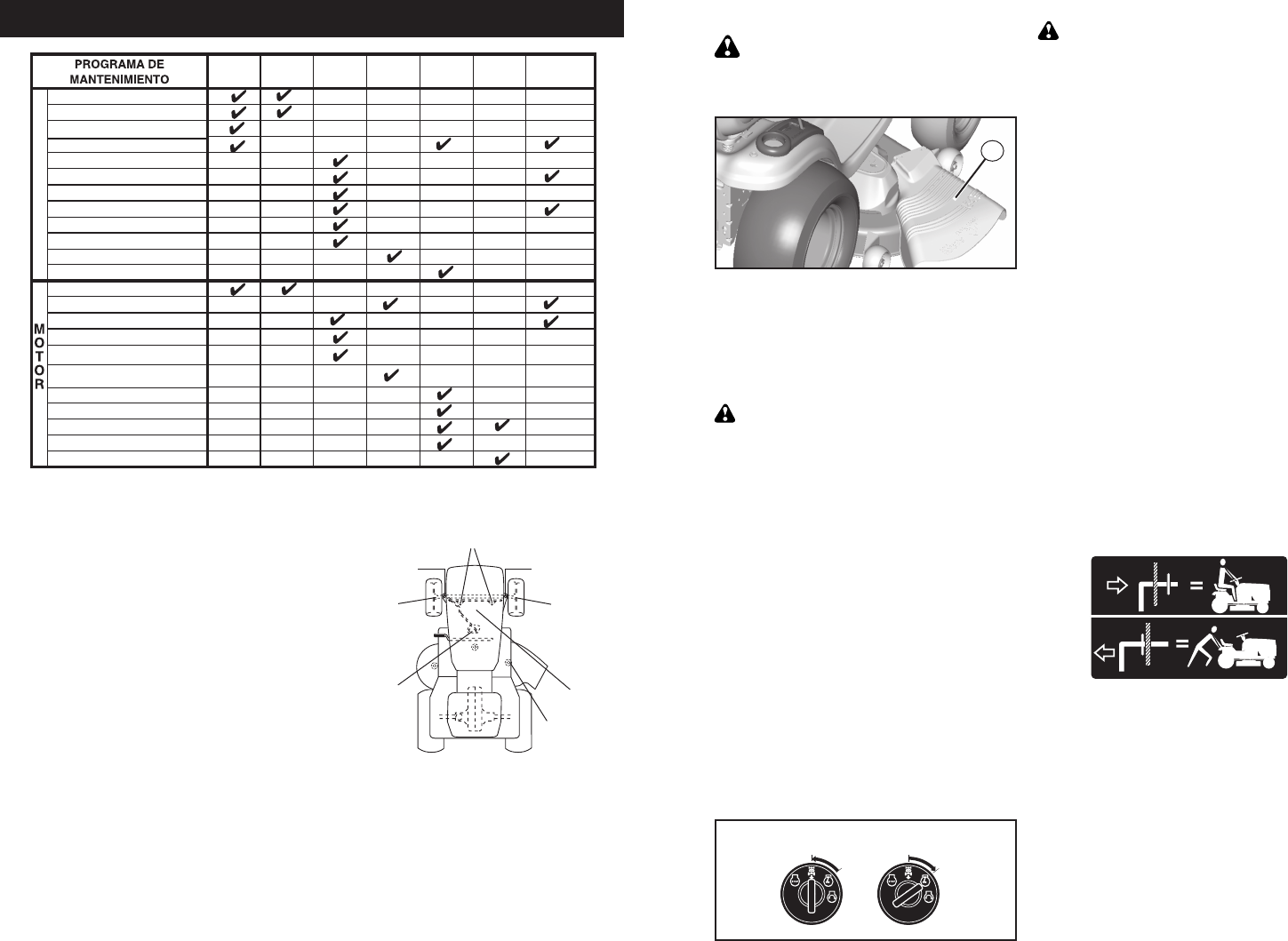
56
MANTENIMENTO
RECOMENDACIONES GENERALES
La garantía de este tractor no cubre los artículos
que han estado sujetos al abuso o a la negligen-
cia del operador. Para recibir todo el valor de
la garantía, el operador tiene que mantener la
se ga do ra según las instrucciones descritas en
este manual.
Hay algunos ajustes que se tienen que hacer en
forma periódica para poder mantener su trac tor
adecuadamente.
Al menos una vez cada estación comprobar
si es necesario efectuar los adjustes descritos
en las secciones de Servicio y Ajustes de este
manual.
• Una vez al año, cambie la bujía, limpie o cam-
bie el filtro de aire y revise si las cuchillas y las
correas están desgastadas. Una bujía nueva y
un filtro de aire limpio aseguran una mezcla de
aire-combustible adecuada y le ayudan a que
su motor funcione mejor y que dure más.
ANTES DE CADA USO
1. Revise el nivel del aceite del motor.
2. Revise la operación de los frenos.
3. Revise la presión de las llantas.
4. Verifique que el sistema de presencia del
operado y el sistema del ROS funcionen
adecuatamente.
5. Revise si hay sujetadores sueltos.
IMPORTANTE: No aceite o engrase los puntas
pivotes, los que tienen rodamientos de nilón
especiales. Los lubricantes viscosos atraerán
polvo y mugre, lo que acortara la duración de
los rodamientos auto-lubricarse, use solamente
un lubricante tipo grafito de polvo seco in forma
moderada.
Revisar la operación del freno
Revisar la presión de las llantas
Vérifiéz la commande de présence
d'opérateur et le sistema d ROS
Revisar si hay sujetadores sueltos
Afilar/cambiar las cuchillas de la segadora
Tabla de lubricación
Revisar el nivel
Revisar el nivel del aceite del motor
Cambiar el aceite del motor (con filtro)
Limpiar el filtro de aire
Limpiar la rejilla de aire
Cambiar el filtro de aceite (si equipado)
Limpiar las aletas de enfriamiento
Cambiar la bujía
Cambiar el cartucho de papel del filtro de aire
Cambiar el filtro de combustible
Inspeccione las correas trapezoidales
Cambiar el aceite del motor (sin filtro)
1- Cambiar más a menudo cuando se opere bajo carga pesada o en ambientes con altas temperaturas
2- Dar servicio más a menudo cuando se opere en condiciones sucias o polvorosas.
3- Cambiar las cuchillas más a menudo cuando se siegue en suelo arenoso.
4- No requerido si equipado con una batería libre de mantenimiento.
5- Vea “LIMPIEZA” en la sección de Mantenimento de este manual.
T
R
A
C
T
0
R
3
2
2
2
2
1
,
1,2
2
4
5
1,2
Compruebe La Nivelación Del Cortacéspedes
Limpie los residuos de la placa de dirección.
Limpiar la batería y los terminales
Inspeccionar el silenciador/
amortiguador de chispas
CADA
8
HORAS
CADA
25
HORAS
CADA
50
HORAS
CADA
100
HORAS
CADA
TEMPORADA
ALMACENAMIENTO
ANTES DE
CADA USO
Revisar el enfriamiento del transeje
TABLA DE LUBRICACIÓN
➀ Grasa de proposito general
➁ Refiérase a la sección del “MOTOR” en Mantenimiento
➁ Motor
➀ Accesorio
de Grasa del
Rodamiento de
la Rueda
Delantera
➀ Accesorio de
Grasa del Arbol
➀ Accesorio de
Grasa del Arbol
➀ Accesorio
de Grasa del
Rodamiento
de la Rueda
Delantera
➀ Plancha
del engranaje
de Sec tor de
Dirección
➀
Perno articulado del volant
➀Accesorio
de grasa
del mandril
17
TOWING CARTS AND OTHER AT TACH-
MENTS
Tow only the attachments that are rec om-
mend ed by and comply with spec i fi ca tions
of the manufacturer of your tractor. Use
common sense when tow ing. Too heavy
of a load, while on a slope, is dangerous.
Tires can lose traction with the ground and
cause you to lose control of your tractor.
S
0
2
8
2
8
ROS "ON" Position
Engine "ON" Position
(Normal Operating)
TO OPERATE ON HILLS
WARNING: Do not drive up or down
hills with slopes greater than 15° and do not
drive across any slope. Use the slope guide
provided at the back of this manual.
• Choose the slowest speed before starting
up or down hills.
• Avoid stopping or changing speed on hills.
• If stopping is absolutely necessary, push
brake pedal quickly to brake position and
engage parking brake.
• To restart movement, slowly re lease park-
ing brake and brake ped al.
• Slowly depress appropriate drive pedal to
slowest setting.
• Make all turns slowly.
TO TRANSPORT
When pushing or towing your tractor, be
sure to disengage transmission by placing
freewheel control in free wheel ing po si tion.
Free wheel control is located at the rear
drawbar of tractor.
• Raise attachment lift to highest position
with at tach ment lift control.
• Pull freewheel control out and into the slot
and release so it is held in the disengaged
position.
• Do not push or tow tractor at more than
two (2) MPH.
• To reengage transmission, reverse above
procedure.
02203
NOTE: To protect hood from damage when
transporting your tractor on a truck or a trailer,
be sure hood is closed and secured to tractor.
Use an appropriate means of tying hood to
tractor (rope, cord, etc.).
REVERSE OPERATION SYSTEM (ROS)
Your tractor is equipped with a Reverse
Operation System (ROS). Any attempt by
the operator to travel in the reverse direction
with the attachment clutch engaged will shut
off the engine unless ignition key is placed
in the ROS "ON" position.
WARNING: Backing up with the at-
tachment clutch engaged while mowing is
strongly discouraged. Turning the ROS "ON",
to allow reverse operation with the attach-
ment clutch engaged, should only be done
when the operator decides it is necessary to
reposition the machine with the attachment
engaged. Do not mow in reverse unless
absolutely necessary.
USING THE REVERSE OPERATION
SYSTEM -
Only use if you are certain no children or
other bystanders will enter the mowing area.
1. Depress brake pedal all the way down.
2. With engine running, turn ignition key
counterclockwise to ROS "ON" position.
3. Look down and behind before and while
backing.
4. Slowly depress reverse drive pedal to
start movement.
5. When use of the ROS
is no longer
needed, turn the ignition key clockwise
to engine "ON" position.
TO STOP MOWER BLADES -
• Disengage attachment clutch con trol.
CAUTION: Do not operate the mower
without either the en tire grass catcher, on
mowers so equipped, or the deflector shield
(S) in place.




